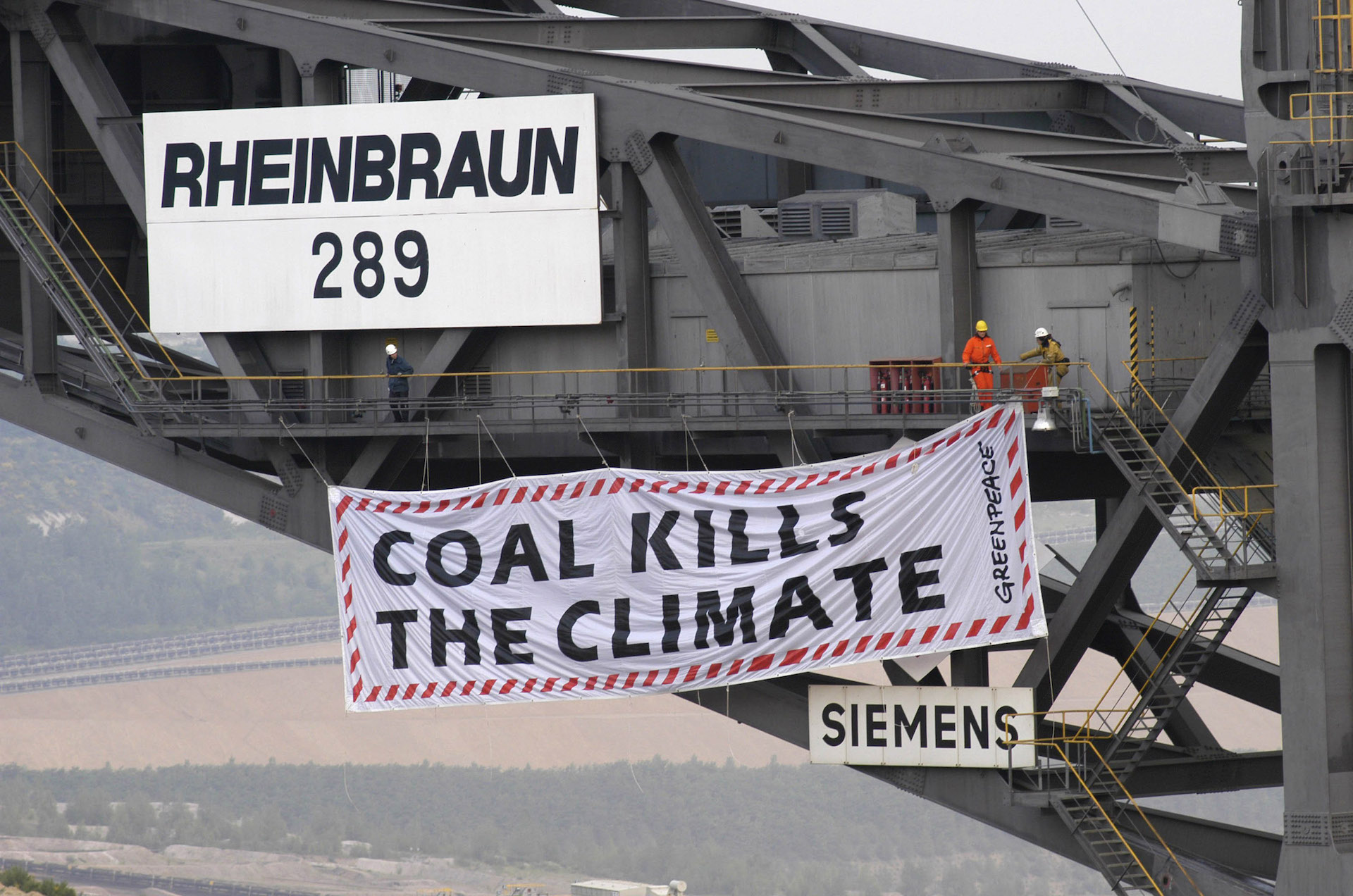
Greenpeace activists protest coal mining in Dueren, Germany. The bar is getting higher for CEOs who claim they are running a sustainable business.
Photo: plus49/Construction Photography/Avalon/Getty Images
In a time when ESG is coming under increased scrutiny for ethics-washing, the bar is getting higher and higher for leaders and CEOs to operate in a truly sustainable way. Clarke Murphy recently stepped down as CEO of Russell Reynolds Associates and has written a book called Sustainable Leadership, Lessons of Vision, Courage, and Grit from the CEOs Who Dared to Build a Better World.
MURPHY: One of the key findings from the research we’ve done is that 45% of leaders say their sustainability journeys are motivated by brand management concerns, rather than because they see sustainability as a lever for value creation. This is frustrating, and I think there’s a fair bit of awakening that needs to happen when it comes to talk versus action.
I firmly believe that we have hundreds of very successful sustainable leaders, but the reality is that we need tens of thousands if we are to make the progress we need on climate, diversity and other sustainability issues. Capital and technology won’t solve these problems alone. We need leaders who are willing to completely rethink their business models, their operations and their supply chains.
So in this book, I interview sustainable leaders who have been most active (and most successful) to understand what they did right, what they did wrong and what advice they have for other leaders, either in the boardroom or further down the organization, who are looking to become more involved in sustainability and more action-orientated.
Do Not Try to Save the World
BRINK: So what would your top three tips be coming out of all those conversations?
MURPHY: We have spent a lot of time analyzing the DNA of successful sustainable leaders. So our first tip is to really understand the specific competencies and mindsets that sustainable leaders show and then scan your entire organization to find people with these skills. It’s about developing them and catapulting them into positions of power.
Second, as much as you might think that, as a senior executive, you have listened to your organization, to your customers, or your supply chain, the facts probably show that you have not done so nearly enough. The most successful sustainable leaders we analyzed have gone deeper and broader than most. So your listening needs to be better, deeper, broader. That’s how you understand what your company is really capable of doing.
The best sustainable leaders we’ve analyzed commit to audacious, long-term goals, and have the courage to make decisions that may be unpopular with more short term-oriented stakeholders.
Third, do not seek to save the entire world (at least not at the start). Pick just one or two sustainability issues to focus on and measure progress on, and keep that up for the next five years. And then, when the organization sees the progress, many other things will happen spontaneously. There are sparks waiting to turn into a flame. But start simply and do it well.
BRINK: What kind of qualities do you look for in a modern sustainable leader?
MURPHY: We really look for five key things. It all starts with having the right mindset. Those who are making the most progress on sustainability truly believe that the role of companies is not just to turn a profit, but also to be a force for good in the world, delivering real value for people and the planet.
Then, beyond that, it is really four key competencies — all of which are behavioral, predictable and testable.
Multi-level systems thinking: Your business is already complex in so many ways — and now we’re layering environmental, climate, social and governance issues on top. Not everyone can handle that. So we look at whether people have the conceptual thinking to handle complexity. It’s about recognizing your business sits within an interconnected ecosystem and then being able to navigate through it.
Long-term activation: Sustainability programs will extend long after your tenure as CEO or as a C-suite executive. In fact, the greatest benefits will probably be realized when you’re no longer in the job. Can you really, really handle that and commit to that? Some people can, some people can’t. The best sustainable leaders we’ve analyzed commit to audacious, long-term goals, and have the courage to make decisions that may be unpopular with more short term-oriented stakeholders.
Stakeholder inclusion: Sustainable leaders have a high level of sociability, which means they are able to go into diverse groups of people, regulators, or even competitors and draw out really interesting ideas, find opportunities for partnership, and ultimately bring everyone along with them on their journey. We have a funny phrase at the moment that being a leader is less about leading and more about creating followers. If you’re not creating followership, you’re just taking a walk.
Disruptive innovation: This is about shooting for the moon. It’s about being bold and innovative, and even if you fail, you don’t give up. It’s about having a sense of resilience and persistence around change. And when it turns out you were wrong, you go back and correct course. It’s about being a much bolder thinker and a more resilient leader than the kind of omnipotent superman or superwoman of yesteryear.
BRINK: Do you see the current economic climate knocking some CEOs off course?
MURPHY: Absolutely. No question. They may say, “Well, I can’t afford this right now.” But if they do, they will lose customers and talented employees or executives.
I look at it as a barbell of pressure. One end of the barbell is institutional investors saying, “I will value a more sustainably operated company.” And the other end of the barbell are customers who say, “I’ll pay a little bit more for a sustainable product,” as well as employees who say, “I’d rather work for a purpose-driven successful company than not in certain parts of the world.”
So it is a shortsighted company that says, “I can’t afford to do this for a couple of years.”







